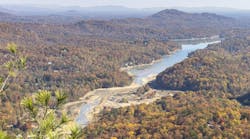About the author: James Crockett is air sweeper products manager for Elgin Sweeper. Crockett can be reached at [email protected].
Long ago, when the Lummi American Indian tribe settled near a lake in the northwestern corner of today’s state of Washington, they called the lake Whatcom, their word for “loud water.” The name endures, with Lake Whatcom providing both freshwater and recreational opportunities to the residents of nearby Bellingham and the greater community of Whatcom County.
Local governments, led by the city of Bellingham’s storm water utility, are striving to keep Lake Whatcom’s “loud water” from becoming “cloud water” by reducing the volume of algae bloom-producing phosphorus that enters the lake through storm water runoff and storm sewer discharges.
The Locale
A city of 80,000 residents nestled along the shores of Bellingham Bay in northeastern Puget Sound, Bellingham is located about 90 miles north of Seattle. Following the advice that “an ounce of prevention is worth a pound of cure,” Bellingham focuses on preventing phosphorus from entering the lake through a disciplined approach to sweeping nearly 300 miles of streets, achieving excellent results and the expectation of future success.
“Testing and analysis shows we are preventing significant amounts of phosphorus from entering and polluting Lake Whatcom—by as much as 30% to 50%,” said Bill Reilly, storm water utility manager for Bellingham. “Sweeping definitely contributes to these reductions. Phosphorous load reductions are determined by analyzing the amount of phosphorus in sweeper loads and extrapolating those reductions to the total tonnage removed from the watershed.”
Bellingham’s three street sweepers—including a Crosswind and Crosswind NX model from Elgin Sweeper—provide a first line of defense for the area’s freshwater supply.
“We consider street sweepers a source control tool,” Reilly said. “Streets and storm sewers are conduits for natural pollution sources entering the lake, so our job is to reduce as much pollution as possible at the source. We’ve swept for many years, but around 1990, we started looking at sweeping as more than an aesthetic strategy: It’s also a means to remove material from the streets that otherwise would end up in the lake.”
Protecting Lake Whatcom
Approximately 12 miles long and 1 mile wide, Lake Whatcom is divided into three basins, with maximum depths ranging from 40 to 328 ft. Basin 3 is the lake’s deepest section and is estimated to contain 96% of the lake’s total water volume. The total area of the Lake Whatcom watershed is 56 sq miles.
As a drinking water source, Lake Whatcom’s water quality is in compliance for all tested chemicals, bacteria and turbidity. Bellingham is a participant in the Partnership for Safe Water, and the city’s drinking water also meets the high standards set by this group. For the past 10 years, the city has received the Partnership for Safe Water’s Director Award for commitment to providing safe drinking water.
Lake Whatcom was placed on the U.S. Environmental Protection Agency’s 303(d) list for impaired water bodies in 1998, due to low dissolved oxygen (DO) levels, which are directly related to the amount of phosphorus found in the lake. Low DO levels do not directly affect drinking water quality, but the additional nutrient load results in the growth of algae blooms, raising the costs of water treatment.
As required by the 303(d) listing, Washington’s Department of Ecology created a computer model to find the total maximum daily load (TMDL) of phosphorus the lake can receive while maintaining adequate DO levels. This TMDL calculation set the objective for managing and preventing phosphorus pollution of Lake Whatcom, and is represented in the 2010-2014 Work Plan for Lake Whatcom, adopted by the city of Bellingham, Whatcom County and Water District 10.
Most phosphorus enters the lake as runoff from lawns, gardens and streets. In 2005, fertilizers containing phosphorus were banned in an effort to reduce the amount of phosphorus entering the lake. The city of Bellingham and Whatcom County also restricted development activities such as annual land clearing from Oct. 1 to May 31 to prevent runoff from exposed soil during high precipitation months.
Storm Water Utility Provides Focus
“We’re part of the Puget Sound estuary,” Reilly said. “The Puget Sound Partnership was set up to manage and eliminate water pollution sources. When the city enacted its own ordinances to meet requirements of the Puget Sound Plan, we divided the duties of the public works department and set up a separate storm water utility.”
Street sweeping is funded by the storm water utility and the Bellingham street fund. The city also assesses runoff fees based on surface coverage of all private property.
“We sweep the reservoir (lake) area every two weeks. And we sweep the city’s downtown area frequently, as there are more pollutants on the arterial streets,” Reilly said. He said that downtown sweeping usually is performed at night, when cars are off the streets.
The most important seasonal sweeping happens in late summer, before the fall rains can create a so-called “first flush” event—a rain that washes large quantities of accumulated debris and pollutants into the water system. The storm water utility also sweeps leaves in the fall and spring.
“Leaves are a significant contributor of nutrients to the lake, so our goal is to keep them out of the storm sewers and out of the lake,” Reilly said.
Sweepings are collected and managed as waste. While most material is taken to landfills, leaves are segregated for composting. “We have a lab that analyzes and typifies wastes to determine the least onerous way to dispose of them,” Reilly said.
The utility’s source control strategy also includes a catch basin cleaning program that uses three vacuum trucks. While source control tactics like sweeping and catch basin cleaning are effective, Bellingham also has invested in storm water end-of-pipe solutions including ponds, sand filters and media treatment systems—the gamut of best practices—designed to remove pollutants from the storm water sewer system before that water gets into the lake.
“End-of-pipe solutions are very expensive,” Reilly said, “so the street sweeping and catch basin cleaning programs take on additional importance as ways of controlling those costs.”
Bellingham also operates a storm water hotline. This is a requirement under the permitting regulations of the National Pollution Discharge Elimination System that cover Bellingham’s storm water utility.
“Keeping our sweepers performing productively is very important,” Reilly said. “We count on street sweeping as the foundation of our phosphorus reduction program. We can’t reach our goals without productive sweepers.”
Sweeper Features
The Elgin Crosswind sweeper is a regenerative air sweeper with a high performance blower fan constructed from Hardox branded steel for maximum service life. It features a 12-ft sweeping path, 8-cu-yd hopper capacity and a 240-gal water tank. Easy to operate and simple to maintain, the sweeper is operated by simple rocker switches and comes with a complete set of gauges. The rear dump sweeper may be mounted on a conventional or cabover chassis, and is capable of travel at highway speeds.
The Crosswind NX sweeper provides higher filtration capability to capture finer particulate matter. The system incorporates an array of vertically-oriented filter bags, which provide high efficiency filtration of 99.997% at 0.5 µ.
Reilly explained that the Crosswind NX sweeper was purchased recently with a state grant to be operated and maintained by Bellingham, but also used for Whatcom County, the city of Ferndale and the Port of Bellingham, which operates two large marinas, port facilities and the Bellingham International Airport.
“As the Crosswind NX is more fully integrated into our sweeping operations, its finer filtration capabilities will accelerate our progress in controlling phosphorus pollution,” Reilly said.
While the city has made great progress in reducing phosphorus contamination of Lake Whatcom, Reilly said he expects even better results in the coming years.
“We have to throw everything at this challenge,” Reilly said. “We know we have a lot of work ahead of us.”
Download: Here


